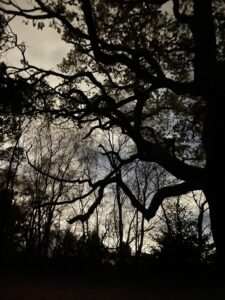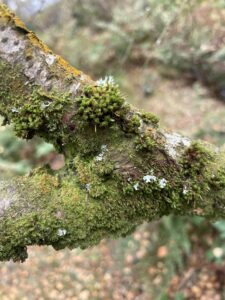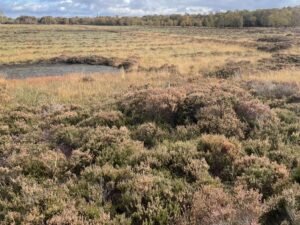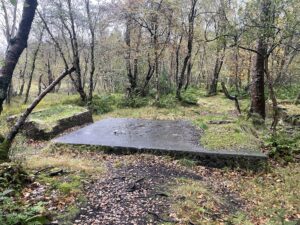
Our desires stare back at us, yellow-eyed and snarling, from the thickets of the mind. (George Monbiot, Feral)
My friend Cairan is visiting for the evening, and I persuade him that a pre-dinner walk round the Moss will be a good idea. We meet at the train station in a downpour. The clocks have changed at the weekend, so it is now much darker at this time. I am not sure whether Cairan’s initial enthusiasm has persisted. By his own admission, he is ‘not an outdoors kind of person’ and any hopes he may have had of a gentle stroll on a sunny autumn evening will need to be adjusted. But he is well prepared with heavy boots and a warm coat, and after a brief pit stop at home to drop off a bag and a dog (Clyde has already had his turn), we are soon entering Lenzie Moss at the end of my street, just as the rain holds off.
The woodland trail is hard to see. We stand for a moment to let our vision adjust and slowly the faint outline of Bea’s Path fades into view. We take tentative steps northwards. This is only the second time that I have visited this place after dark, and it feels very different. Occasionally, we are blinded by bright torchlight coming in the other direction and greeted by voices whose owners we cannot make out until they have passed. Outside lights from the houses off Blackthorne Avenue illuminate the path by the primary school. There seems an unnecessary level of light pollution here.
Cairan tells me that keeping parks and green places unlit can actually make these areas feel safer for people passing through. When pathways and walking routes are saturated in light, the wooded areas and grasslands beyond become hidden, unseeable places. In public parks like Glasgow’s Kelvingrove, beside which I used to live, ‘sensitive’ lighting has recently been added, partly to avoid this effect.
We peer into the darkness and wonder what lurks in there. A couple of years ago, Cairan and I spent a week working at Capital Theatres in Edinburgh to devise a new theatre performance, which we called Beasts. The idea was to present some fictional verbatim interviews with people who had seen big cats – suburban encounters with wild animals. We spliced these together with shaky film footage and photographs of possible sightings. Then the script shifted to speculative futures with cities taken over by nature. We now have some fragments of text and a loose structure for a show. Both of us hope we will find an opportunity to return to it one day, but the project has been placed on the back burner for now. Walking round the Moss this evening reminds us of the topic and raises the possibility of something wild hiding out there. I am hoping to see a shift of light, a displaced tree branch – something to help me imagine that a big cat might be close by.
A few days ago, I stood in my garden and watched a bat flying back and forth over my fence. I wonder if we will at least see a bat this evening. But if they are out there, they are also imperceptible in the darkness. Then a small white moth catches the light as it flutters by and I’m happy enough with that. We take a lot of photographs as we walk (Cairan has brought his camera, which is much better than the one on my iPhone). The trees are silhouetted against the sky and the First Quarter moon shines brightly as clouds drift past. As we join the boardwalk, the light show is enhanced by headlights from the vehicles crossing the railway bridge.
The vista opens up and we look up at the stars. We make out the Plough (seven of the bright stars of Ursa Major) very clearly, but this is the extent of our knowledge of astronomy. Several planes pass overhead, bright and noisy. We see a succession of trains as well and as we get closer, we can see through the windows into the well-lit carriages. The commuters don’t know that they are being observed from the shadows. Looking further to the west, the city is visible in a way that I have never realised during the day; thousands of tiny lights marking the urban area.
I don’t know what to make of all this movement, light and energy. It is mesmerising but we are standing by the heather-covered ‘peat hill’ that I climbed with Alison and also sat beside with Cathy early one morning. On those previous walks, this place felt quiet and calm – a spot to rest and reflect. This evening, the boardwalk is a nexus of transport routes. Rail, road and air carry people in all directions and each journey flashes past. I am taking in a lot of new information, and I feel tense and out of place.
We reach the end of the boardwalk, and I offer Cairan the option of walking through the bog and into the wood or taking the pathway along the railway line. He chooses the less muddy route and we set off back towards my house. We follow a boundary line between the modern infrastructure of the rail network and the old birchwood that veils the bog. I stay alert, attentive to any potential motion in the undergrowth.
As we turn back onto my street, I feel overwhelmed. I realise that I have been exerting all my senses during this walk. The lights and sounds and darkness have made a now familiar place feel strange and unknowable again. While there are no big cats staring back at us from the trees, the trees themselves seem wild and strange. While I welcome this feeling, I am still processing the uncanniness of the encounter.
I am pleased when Cairan tells me that he has had quite the opposite experience. He has been feeling stressed with work and had mentioned earlier to his boyfriend that he had probably taken on too many things this week. When I met him from the train earlier, he was worrying about an early start for a work trip tomorrow. Cairan tells me that the walk round the Moss has been a calming experience. Slow pace, hushed voices and the lights and sounds of the nighttime Moss have been good for him, and he now feels able to relax and enjoy the rest of the evening. Luckily, I have a pot of bolognaise and a bottle of wine waiting for us at home, which I am sure will taste all the better for the hour we have spent in the wild outdoors.


